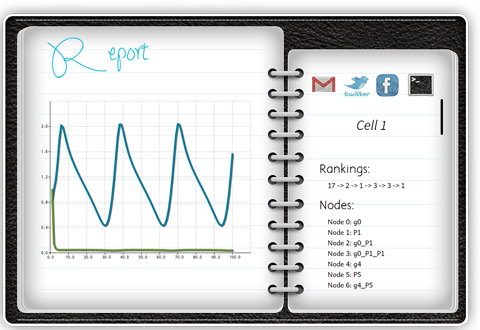Team:USTC-Software/software.html
From 2012.igem.org
All-in-One Software
To combine experimental data, biological networks, and mathematical networks into one integrated software, we build a suite of applications for the convenience of both common users and biological researchers. Therefore, the all-in-one software has powerful functions including displaying output results, viewing 3D graph of GRNs and guiding further experiments.
As to experimental data, this all-in-one software uses time courses as its input. The convenience and user friendly input interface let users feel comfortable and easy to interact with. In generating possible biological network candidates, genetic algorithm, which is a commonly used algorithm in computer science, is also used for shorter calculation time and smaller computational space. The mathematical models accounts for the most important part in this all-in-one software. In our program, ODE model is used to analyze the reaction network of the GRN. Other mathematical models including Dynamic Baysian Network or Boolean Network have been discussed by both mathematicians and biological researchers.
To develop an all-in-one software is indeed a very smart ideas for people who are interested in synthetic biology. Also we believe our software can make a difference to help this group of people.
Map
Console
Sandbox
Report
Regulon Lib: a Clotho App
To better assist synthetic biological researchers and other iGEM programmers, we integrate our database and recursion algorithm into one independent application on Clotho platform(Clotho is a java based platform for both software users and developers). Our clotho app, with the name “Regulon Lib”, mainly aims at finding proper regulators and regulatees in the two matrices. To make our app more user friendly, we optimize the GUI of our app and write a detailed user manual for ordinary users. It has two main features: serving two modes for users to implement GRN regulatory matrix, aiding users to find vivo valid regulators and regulatees for their experiments.
1) Main Page: Library of regulations.
The only inputs are your regulatory matrix size and elements of the matrix. The picture takes 4 positive regulations for example. Right below the input table, two buttons respectively named ”mode 1” and “mode 2” mean the database you will search in. To say in a more specific way, by clicking “mode 1” operon-operon matrix is used and by clicking “mode 2” gene-promoter matrix is employed. The output results of using these two modes are pasted below:

The possible regulatory network candidates are shown in the text field. Users can either save it or clear it by clicking right.
2) Search Page: Library of regulons.
By clicking “Search” in the menu bar, two kinds of search page is for users to choose. The example presented here only takes account of “Search In Operon-Operon”.

The table on the right side includes all the regulators and the left side the regulatees. These are choice pools for user to select one. As for the two tables in the middle, the right side is called “regulatee candidates table”, in which all the regulatees corresponding to a certain regulator will be presented here including the regulation type. It is the same for the left table by exchanging the terminology “regulator” and “regulatee”.
For more information about how to use this app to find right regulons, you can refer to user manual of this app.
 "
"




